Rocca Paolina
Città Sotterranea
Useful Information
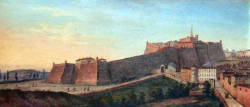
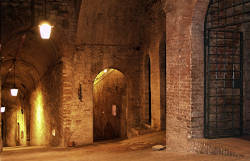
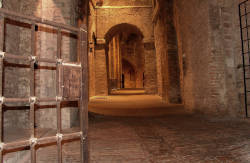
| Location: |
11 Piazza Italia, 06121 Perugia PG.
(43.107784, 12.388425) |
| Open: |
All year daily 6:15-2. [2022] |
| Fee: |
free. [2022] |
| Classification: |
 Underground City Underground City
|
| Light: |
 Incandescent Incandescent
|
| Dimension: | |
| Guided tours: | self guided |
| Photography: | allowed |
| Accessibility: | no |
| Bibliography: | |
| Address: | Rocca Paolina, 11 Piazza Italia, 06121 Perugia PG, Tel: +39-075-368-1405. |
| As far as we know this information was accurate when it was published (see years in brackets), but may have changed since then. Please check rates and details directly with the companies in question if you need more recent info. |
|
History
| 1540-1543 | Rocca Paolina fortress built for Pope Paul III to designs by Antonio da Sangallo the Younger. |
| 1848 | fortress partially destroyed |
| 1860 | rebuilt by Pope Pius IX. |
| 1861 | city annexed by the Kingdom of Italy and fortress finally destroyed. |
| 1932 | underground via Bagliona and the remains of the medieval quarter uncovered and restored. |
| 1965 | restoration works. |
Description
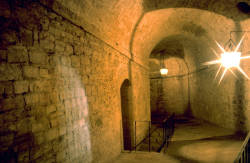
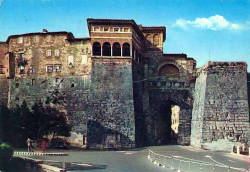
Rocca Paolina (Pauline Rock) is a fortress which built for Pope Paul III to designs by Antonio da Sangallo the Younger. For its construction a large number of Etruscan, Roman and medieval buildings were destroyed. This included over a hundred tower-houses, gates, churches and monasteries. The former streets of the historic city centre became underground passageways. Obviously they were not accessible while it was a fortress, they were part of the foundation. But in 1861 Perugia was annexed by the Kingdom of Italy and the fortress was finally destroyed. The space was then used for erecting new buildings, so the underground structure stayed underground.
They were finally rediscovered in 1931 and excavated, and since the archaeological work is completed it was opened to the public. The passages are accessible without an entrance fee, and as they connect a huge section of the historic city they are used by locals and tourists as comfortable pedestrian tunnels. The entrances are Piazza Italia (escalators), Via Masi, V.le Indipendenza and Porta Marzia (via Bagliona).
 Search DuckDuckGo for "Rocca Paolina"
Search DuckDuckGo for "Rocca Paolina" Google Earth Placemark
Google Earth Placemark Rocca Paolina - Wikipedia (visited: 25-MAY-2022)
Rocca Paolina - Wikipedia (visited: 25-MAY-2022) Index
Index Topics
Topics Hierarchical
Hierarchical Countries
Countries Maps
Maps